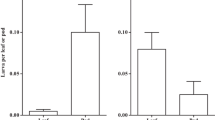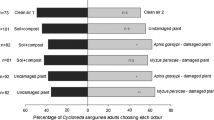Abstract
The responses of the parasitoidCotesia rubecula to differently damaged cabbages were recorded during a series of choice tests. To determine if flyingC. rubecula can discriminate differences in the blend of volatiles emitted by cabbages damaged by different causes and how plant volatiles released from a distant source affect the searching behavior ofC. rubecula once searching on a plant, wasps were presented with a choice of plants located one behind the other and separated by a distance of 15 cm. The sources of damage were: cabbage damaged by the host (Pieris rapae), by a nonhost lepidopteran herbivore (Plutella xylostella), by a nonhost, noninsect herbivore (snail), and by mechanical means. The results showed that the site of first landing and the time spent searching on the leaves was influenced by the type of damage inflicted on plants. Wasps preferred to land on cabbages damaged by host and nonhost species of Lepidoptera over those damaged by snails and mechanical means. No preference was observed for first landing between cabbages damaged by the two species of Lepidoptera or between cabbages damaged by snails and mechanical means. Cabbage damaged byP. rapae was searched most intensively, followed by cabbage damaged byP. xylostella, cabbage damaged by snails, and cabbage damaged by mechanical means.C. rubecula differentiates between the volatile blends emitted by differently damaged cabbages, and it is attracted to volatiles related to recent lepidopteran damage. Wasps searched longer on freshly damaged than on leaves with older damage.
Similar content being viewed by others
References
Agelopoulos, N.G., andKeller, M.A. 1994. Plant-natural enemy association in the tritrophic system,Cotesia rubecula-Pieris rapae-Brassicaceae (Cruciferae). I. Sources of infochemicals.J. Chem. Ecol. 20:1725–1734.
Auger, J., Lecompte, C., Paris, J., andThibout, E. 1989. Identification of leek-moth and diamondback-moth frass volatiles that stimulate parasitoid,Diadromus pulchellus.J. Chem. Ecol. 15:1392–1398.
Dicke, M., andTakabayashi, J. 1991. Specificity of induced indirect defence of plants against herbivores.Redia 17(3):105–113.
Dicke, M., Van Beek, T.A., Posthumus, M.A., Ben Dom, N., Van Bokhoven, H., andDe Groot, A.E. 1990a. Isolation and identification of volatile kairomone that affects acarine predator-prey interactions: involvement of host plant in its production.J. Chem. Ecol. 16:381–398.
Dicke, M., Sabelis, M.W., Takabayashi, J., Bruin, J., andPosthumus, M.A. 1990b. Plant strategies of manipulating predator-prey interactions through allelochemicals: Prospects for application in pest control.J. Chem. Ecol. 16:3091–3118.
Kaiser, L., andCardé, R.T. 1992. In-flight orientation to volatiles from the plant-host complex inCotesia rubecula (Hymenoptera: Braconidae). Increased sensitivity through olfactory experience.Physiol. Entomol. 17:62–67.
Keller, M.A. 1990. Responses of the parasitoidCotesia rubecula to its hostPieris rapae in a flight tunnel.Entomol. Exp. Appl. 57:243–249.
Nealis, V.G. 1986. Responses to host kairomones and foraging behaviour of the insect parasiteCotesia rubecula (Hymenoptera: Braconidae).Can. J. Zool. 64:2393–2398.
Noldus, L.P.J.J. 1991. The observer: A software system for collection and analysis of observational data.Behav. Res. Methods Instrum. Comp. 23:415–429.
Price, P.W., Bouton, C.E., Gross, P., McPherson, B.A., Thompson, J.N., andWeis, A.E. 1980. Interactions among three trophic levels: influence of plants on interactions between insect herbivores and natural enemies.Annu. Rev. Ecol. Syst. 11:41–65.
Ramachandran, R., Norris, D.M., Phillips, J.K., andPhillips, T.W. 1991. Volatiles mediating plant-herbivore-natural enemies interactions: soybean looper frass volatiles, 3-octanone and guaiacol, as kairomones for the parasitoidMicroplitis demolitor.J. Agric. Food Chem. 39:2310–2317.
Shenefelt, R.D. 1972. Braconidae 4, Microgasterinae,Apanteles, p. 615,in J. Van Der Vecht, and R.D. Shenefelt (eds.). Hymenopterum Catalogus, Vol. 7, W. Junk, The Hague, Netherlands.
Steinberg, S., Dicke, M., andVet, L.E.M. 1993. Relative importance of infochemicals from first and second trophic level in long-range host location by the larval parasitoidCotesia glomerata.J. Chem. Ecol. 19:47–59.
Thibout, E., Guillot, J.F., andAuger, J. 1993. Microorganisms are involved in the production of volatile kairomones affecting the host seeking behaviour ofDiadromus pulchellus, a parasitoid ofAcrolepiopsis assectella.Physiol. Entomol. 18:176–182.
Turlings, T.C.J., Tumlinson, J.H., andLewis, W.J. 1990. Exploitation of herbivore-induced plant odours by host-seeking parasitic wasps.Science 250:1251–1253.
Turlings, T.C.J., Tumlinson, J.H., andLewis, W.J. 1991. Isolation and identification of allelochemicals that attract the larval parasitoid,Cotesia marginiventris (Cresson), to the microhabitat of one of its hosts.J. Chem. Ecol. 17:2235–2251.
Vet, L.E.M., Wäckers, F.L., andDicke, M. 1991. The reliability-detectability problem for foraging parasitoids: usability of 1st and 2nd level stimuli.Redia 17(3):115–119.
Vinson, S.B. 1975. Biochemical coevolution between parasitoids and their hosts, pp. 14–36,in P.W. Price (ed.). Evolutionary Strategies of Parasitic Insects and Mites. Plenum Press, New York.
Vinson, S.B. 1984. How parasitoids locate their hosts: A case of insect espionage, pp. 325–384,in T. Lewis (ed.). Insect communication. Academic Press, New York.
Whitman, D.W., andEller, F.J. 1990. Parasitic wasps orient to green leaf volatiles.Chemoecology 1:69–75.
Zanen, P.O., andCardé, R.T. 1991. Learning and the role of host-specific volatiles during inflight host-finding in the specialist parasitoidMicroplitis croceipes.Physiol. Entomol. 16:381–389.
Author information
Authors and Affiliations
Rights and permissions
About this article
Cite this article
Agelopoulos, N.G., Keller, M.A. Plant-natural enemy association in the tritrophic systemCotesia rubecula-Pieris rapae-brassicaceae (cruciferae): II. Preference ofC. rubecula for landing and searching. J Chem Ecol 20, 1735–1748 (1994). https://doi.org/10.1007/BF02059895
Received:
Accepted:
Issue Date:
DOI: https://doi.org/10.1007/BF02059895




